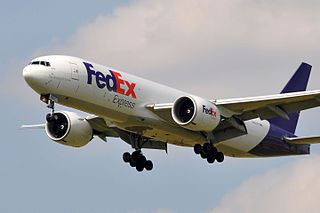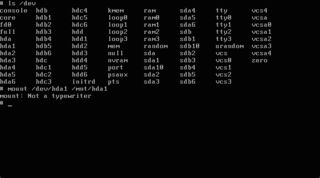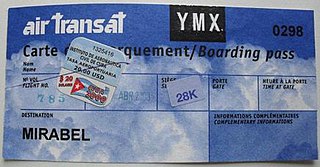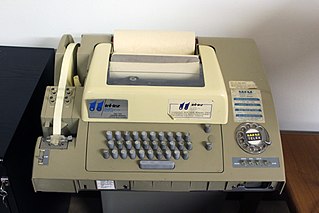
A teleprinter is an electromechanical device that can be used to send and receive typed messages through various communications channels, in both point-to-point and point-to-multipoint configurations. Initially they were used in telegraphy, which developed in the late 1830s and 1840s as the first use of electrical engineering, though teleprinters were not used for telegraphy until 1887 at the earliest. The machines were adapted to provide a user interface to early mainframe computers and minicomputers, sending typed data to the computer and printing the response. Some models could also be used to create punched tape for data storage and to read back such tape for local printing or transmission.

John F. Kennedy International Airport is the main international airport serving New York City. The airport is the busiest of the seven airports in the New York airport system, the 13th-busiest airport in the United States, and the busiest international air passenger gateway into North America. Over 90 airlines operate from the airport, with nonstop or direct flights to destinations in all six inhabited continents.

Cargo airlines are airlines mainly dedicated to the transport of cargo by air. Some cargo airlines are divisions or subsidiaries of larger passenger airlines. In 2018, airline cargo traffic represented 262,333 million tonne-kilometres with a 49.3% load factor: 52.1% for dedicated cargo operations, and 47.9% within mixed operations.

A codeshare agreement, also known simply as codeshare, is a business arrangement, common in the aviation industry, in which two or more airlines publish and market the same flight under their own airline designator and flight number as part of their published timetable or schedule. Typically, a flight is operated by one airline while seats are sold for the flight by all cooperating airlines using their own designator and flight number.

In computing, "Not a typewriter" or ENOTTY is an error code defined in the errno.h found on many Unix systems. This code is now used to indicate that an invalid ioctl number was specified in an ioctl system call.
The Aeronautical Fixed Telecommunications Network (AFTN) is a worldwide system of aeronautical fixed circuits provided, as part of the Aeronautical Fixed Service, for the exchange of messages and/or digital data between aeronautical fixed stations having the same or compatible communications characteristics. AFTN comprises aviation entities including: ANS providers, aviation service providers, airport authorities and government agencies, to name a few. It exchanges vital information for aircraft operations such as distress messages, urgency messages, flight safety messages, meteorological messages, flight regularity messages and aeronautical administrative messages.
Aeronautical Radio, Incorporated (ARINC), established in 1929, was a major provider of transport communications and systems engineering solutions for eight industries: aviation, airports, defense, government, healthcare, networks, security, and transportation. ARINC had installed computer data networks in police cars and railroad cars and also maintains the standards for line-replaceable units.
A passenger name record (PNR) is a record in the database of a computer reservation system (CRS) that contains the itinerary for a passenger or a group of passengers travelling together. The concept of a PNR was first introduced by airlines that needed to exchange reservation information in case passengers required flights of multiple airlines to reach their destination ("interlining"). For this purpose, IATA and ATA have defined standards for interline messaging of PNR and other data through the "ATA/IATA Reservations Interline Message Procedures - Passenger" (AIRIMP). There is no general industry standard for the layout and content of a PNR. In practice, each CRS or hosting system has its own proprietary standards, although common industry needs, including the need to map PNR data easily to AIRIMP messages, has resulted in many general similarities in data content and format between all of the major systems.

The Teletype Model 33 is an electromechanical teleprinter designed for light-duty office use. It is less rugged and cost less than earlier Teletype machines. The Teletype Corporation introduced the Model 33 as a commercial product in 1963 after being originally designed for the United States Navy. There are three versions of the Model 33:

A boarding pass or boarding card is a document provided by an airline during airport check-in, giving a passenger permission to enter the restricted area of an airport and to board the airplane for a particular flight. At a minimum, it identifies the passenger, the flight number, and the date, and scheduled time for departure. A boarding pass may also indicate details of the perks a passenger is entitled to and is thus presented at the entrance of such facilities to show eligibility.

SITA is a multinational information technology company providing IT and telecommunication services to the air transport industry. The company provides its services to around 400 members and 2,500 customers worldwide, which it claims is about 90% of the world's airline business. Around the world, nearly every passenger flight relies on SITA technology.

In aviation, ACARS is a digital datalink system for transmission of short messages between aircraft and ground stations via airband radio or satellite. The protocol was designed by ARINC and deployed in 1978, using the Telex format. More ACARS radio stations were added subsequently by SITA.
This is a list of airline codes. The table lists IATA's two-character airline designators, ICAO's three-character airline designators and the airline call signs. Historical assignments are also included.
A radiogram is a formal written message transmitted by radio. Also known as a radio telegram or radio telegraphic message, radiograms use a standardized message format, form and radiotelephone and/or radiotelegraph transmission procedures. These procedures typically provide a means of transmitting the content of the messages without including the names of the various headers and message sections, so as to minimize the time needed to transmit messages over limited and/or congested radio channels. Various formats have been used historically by maritime radio services, military organizations, and Amateur Radio organizations.
Airline reservation systems (ARS) are systems that allow an airline to sell their inventory (seats). It contains information on schedules and fares and contains a database of reservations and of tickets issued. ARSs are part of passenger service systems (PSS), which are applications supporting the direct contact with the passenger.
Sand Point Airport is a state owned, public use airport located two nautical miles (4 km) southwest of the central business district of Sand Point, a city in the Aleutians East Borough in the U.S. state of Alaska. Scheduled airline service to Anchorage International Airport is provided by Peninsula Airways (PenAir).
WorldTracer is a SITA / IATA service provided for the tracking of lost or delayed baggage. It has been in operation for many years and is used by all airlines that are members of IATA. Most of the low-cost carriers that are based in Europe such as Norwegian Air Shuttle, Wizz Air also use WorldTracer.

The telex network is a station-to-station switched network of teleprinters similar to a telephone network, using telegraph-grade connecting circuits for two-way text-based messages. Telex was a major method of sending written messages electronically between businesses in the post–World War II period. Its usage went into decline as the fax machine grew in popularity in the 1980s.
The Teletype Model 28 is a product line of page printers, typing and non-typing tape perforator and tape reperforators, fixed head single contact and pivoted head multi-contact transmitter-distributors, and receiving selector equipment. Regarded as the most rugged machines Teletype Corporation built, this line of teleprinters used an exchangeable type box for printing and sequential selector "Stunt Box" to mechanically initiate non-printing functions within the typing unit of the page printer, electrically control functions within the page printer and electrically control external equipment.









